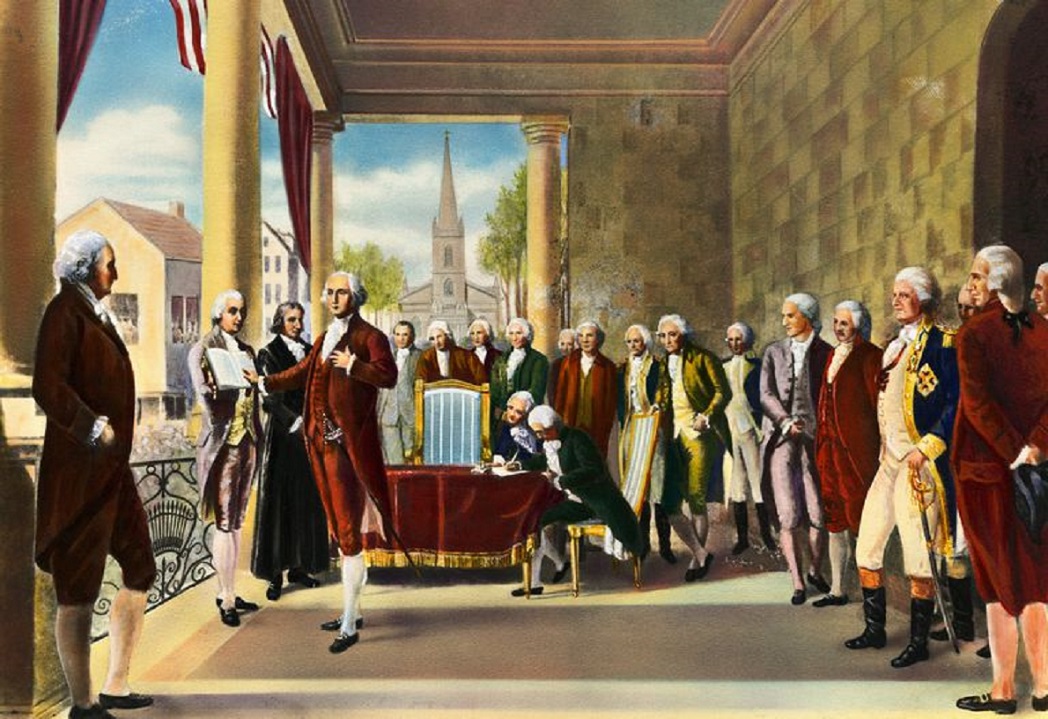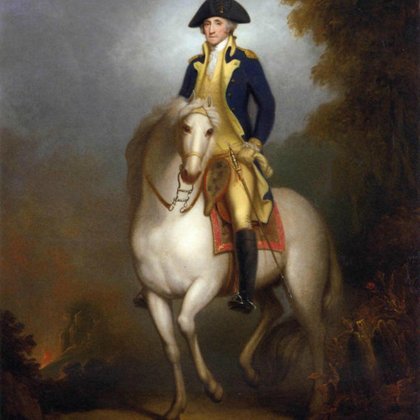GEORGE WASHINGTON (1732 - 1799) SERVED AS THE FIRST PRESIDENT OF UNITED STATE FROM (1789 - 1797).HE WAS FEARLESS IN BATTLE,AND MADE AN HONORARY CITIZEN OF FRANCE.BEFORE BECOMING THE FATHER OF THE NATION, HE WAS A MASTER SURVEYOR.
George
Washington was born on February 22, 1732. His father was Augustine
Washington, who was a prosperous farmer and owned several plantations in
the colony of Virginia. From his first marriage, Augustine had two
sons, Lawrence and Augustine. George was
the first child born to Augustine’s second wife, Mary Bell Washington.
At the time, the family was living at Wakefield Farm in Westmoreland
County, Virginia. By the time George was eleven, his parents had five
more children, 3 boys and 2 girls. George’s family moved several times
during his childhood. When he was 3, in 1735, the Washingtons moved to
Little Hunting Creek Plantation, or as it would later be called Mount
Vernon. Three years later, in 1738, they moved to Ferry Farm on the
Rappahonnock River opposite Fredricksburg, Virginia, where he would live
for the remainder of his childhood.As George grew up, he was allowed to
play in the corner of the garden, where he planted and grew his own
little garden. When he was big enough to ride, his father gave him his
own pony and he soon became an expert horseman.George’s mother
was a troubled person, and this affected her children. Mary Ball
Washington was the child of a marriage between a wealthy gentleman who
married a family housemaid who had no education. It was a legitimate
marriage, so Mary eventually inherited land, slaves, and money from her
father, but she was ill-prepared to step into the role of mother and
mistress of a successful household. Soon, George was the tallest,
strongest, fastest, and best rider of any of the boys his age. When he
played with games or races with his friends, he could always win.George
received most of his education at home. Like most boys at the time, he
learned arithmetic, geography, astronomy, and handwriting and copying by
copying into a copy book from the book called Rules of Civility and
Decent Behavior. George’s mother had plans to send him to England to
finish his education. Tragically, George’s father, Augustine died in
1743 when George was only eleven years old and his death put an end to
his mother's plans. George would receive the rest of his education in
the colonies. Although Augustine was fairly wealthy, George received
none of his father’s money or property. As the eldest, Lawrence received
the majority of their father's inheritance including Little Hunting
Creek Plantation. Augustine Jr. also received some inheritance while the
rest was given to Mary Washington to help take care of herself and her
remaining children. After his father died, George moved in with Lawrence
who became a surrogate father to him. Lawrence raised him until he
started working as a surveyor.Had
Augustine lived, George would likely have gone to England to attend the
Appleby School as his older brothers had done. Instead, George had
tutors and attended a school near Fredericksburg run by an Anglican
priest’ his education was not as robust as
what a prep school could have provided.Though there would certainly
have been disappointment about missing a prep school education, George
must have been happy that he got to live with Lawrence. Lawrence
inherited land along the Potomac River,he called it Mount Vernon.With
extra time on his hands, George taught himself how to use surveying
instruments. This prepared him to be of service as he got older. His
brother’s marriage to a daughter of Colonel William Fairfax, one of the
most powerful landowners in Virginia, provided him with connections to
the wealthy who needed surveying work done. As a result, he began to
acquire wealth on his own.In 1752 Lawrence died, which must have been a
very sad time for George. Lawrence left him some land but Mount Vernon
itself was left to Lawrence’s wife. Women of that day needed to remarry
quickly as their rights as an unmarried woman were so few; Lawrence’s
wife did remarry so she soon sold the property to George,he treasured
that land for the rest of his life.After Lawrence died, George, then
only 20, also campaigned to be appointed to Lawrence’s position as
adjutant for the militia of his local Virginia military district. By the
standards of the gentlemen who usually held such posts, George was
young and relatively poor; he was given the title of major but assigned
to a less populated outlying district. Nonetheless, Washington was
beginning to be noticed.
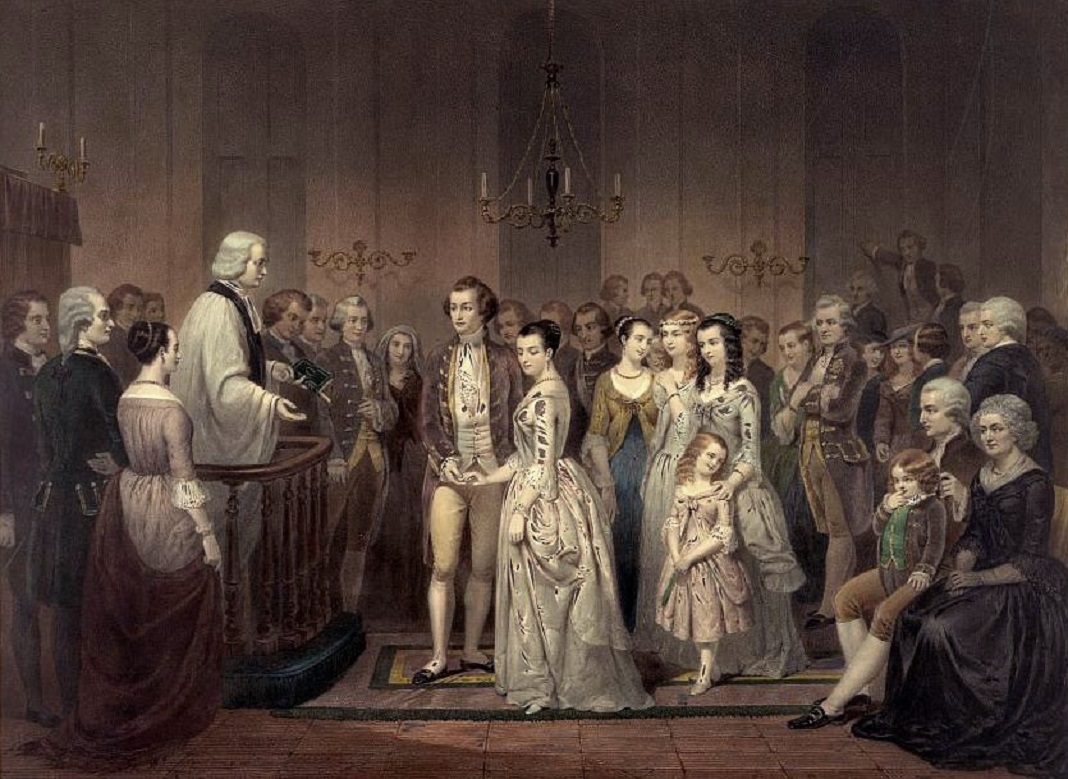
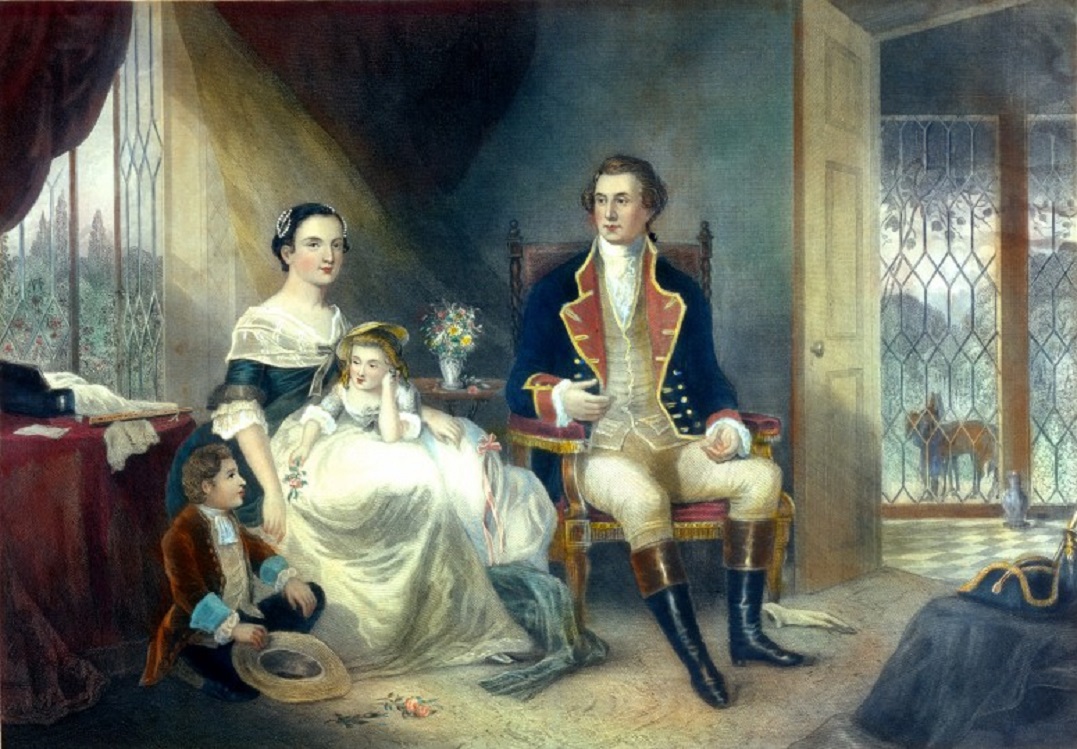 The
attraction between George and Martha was mutual, powerful, and
immediate. Martha was charming, attractive, and wealthy. George had his
own appeal, standing over six feet two inches tall, he was an imposing
figure with a formidable reputation as a military leader. George had
also recently inherited the Mount Vernon estate from his elder
half-brother Lawrence who passed away in 1752, following the death of
Lawrence’s daughter Sarah in 1754.At
the end of 1758, Washington resigned his military commission. On
January 6, 1759, less than ten months after their initial meeting and
less than eighteen months after her husband’s death, Martha Dandridge
Custis married George Washington at her home in New Kent County.
The
attraction between George and Martha was mutual, powerful, and
immediate. Martha was charming, attractive, and wealthy. George had his
own appeal, standing over six feet two inches tall, he was an imposing
figure with a formidable reputation as a military leader. George had
also recently inherited the Mount Vernon estate from his elder
half-brother Lawrence who passed away in 1752, following the death of
Lawrence’s daughter Sarah in 1754.At
the end of 1758, Washington resigned his military commission. On
January 6, 1759, less than ten months after their initial meeting and
less than eighteen months after her husband’s death, Martha Dandridge
Custis married George Washington at her home in New Kent County.
George’s father, Augustine raised horses and took pride in keeping his horses blood lines pure. After he died, Mary Washington worked to continue his work with the horses. One colt in particular was her favorite. It was a high-spirited horse that had not yet been broken though not for lack of trying. Young George Washington, however, was determined to ride the colt. One morning, George was with his brothers and friends in the pasture where this untrainable horse was kept. George admired the spirited horse prancing about and told his companions that he would ride the horse if they would help put a bridle on it. Surrounding the horse, the boys managed to back the horse into a corner and slip the bridle on it. Leaping onto the back of the horse, George seated himself firmly and the boys let go of the bridle. The colt erupted with rage and surprise. It reared, ran and jumped trying to throw George off his back. His companions were quite worried that he would fall and get hurt but George was an excellent rider and stayed on the horse no matter how hard the colt tried. The colt made one final attempt to throw its rider by bounding into the air. Sorrowfully, the last leap burst a blood vessel and the colt fell down dead. George had ridden the horse and had handled it like a master, but it had cost the life of his mother’s favorite horse.Dejectedly the boys returned to the house. As they were eating breakfast, their mother who knew the boys had been out to the pasture, asked them how the colt was doing. Bravely, George spoke up and said, "He is dead madam, I killed him." Then he went on to tell the whole truth about what he had done. Although Mary Washington was sorrowful at the news of her favorite horse’s death, she was prouder of her son for his honesty, so she controlled herself and told him, "It is well; but while I regret the loss of my favorite, I rejoice in my son who always speaks the truth.When George was about six years old, he was made the wealthy master of a hatchet! Of which, like most little boys, he was immoderately fond, and was constantly going about chopping every thing that came in his way. One day, in the garden, where he often amused himself hacking his mother’s pea-sticks, he unluckily tried the edge of his hatchet on the body of a beautiful young English cherry-tree, which he barked so terribly, that I don't believe the tree ever got the better of it. The next morning the old gentleman, finding out what had befallen his tree, which, by the by, was a great favorite, came into the house; and with much warmth asked for the mischievous author, declaring at the same time, that he would not have taking five guineas for his tree. Nobody could tell him any thing about it. Presently George and his hatchet made their appearance.At age 16 George started war play. When he joined the army, he began to learn very quickly what battle was like, and what was important in crucial moments. He learned to aim and fire a gun successfully, how to plan a battle, and he learned a lot about sword play. He was also taught how to serve and Not long after he joined the army, the French and Indian war began. Washington, at that time a lieutenant colonel, was sent in to help. When he and British General Edward Braddock were sent with a troop to take Ohio back from the French, they were ambushed by a French and Indian force. Braddock was mortally wounded, and the troop devolved into utter chaos, trying to retreat.Then Washington stepped up to fill the gap. He raced around the field collecting Braddock's troops and made possible the retreat of all the men together. That entire troop owed their lives to George Washington that day.Washington fought for and served the mother country well, but when it became time to choose sides for the Revolutionary War.He knew where his allegiance lay.When George was in Congress, he believed they ought to make a stand and fight or not make a stand at all. It was this driving, forward attitude on top of his military experience that made the congress realize that he would be perfect to lead their army. Thus he became General George Washington, Commander-in-Chief.
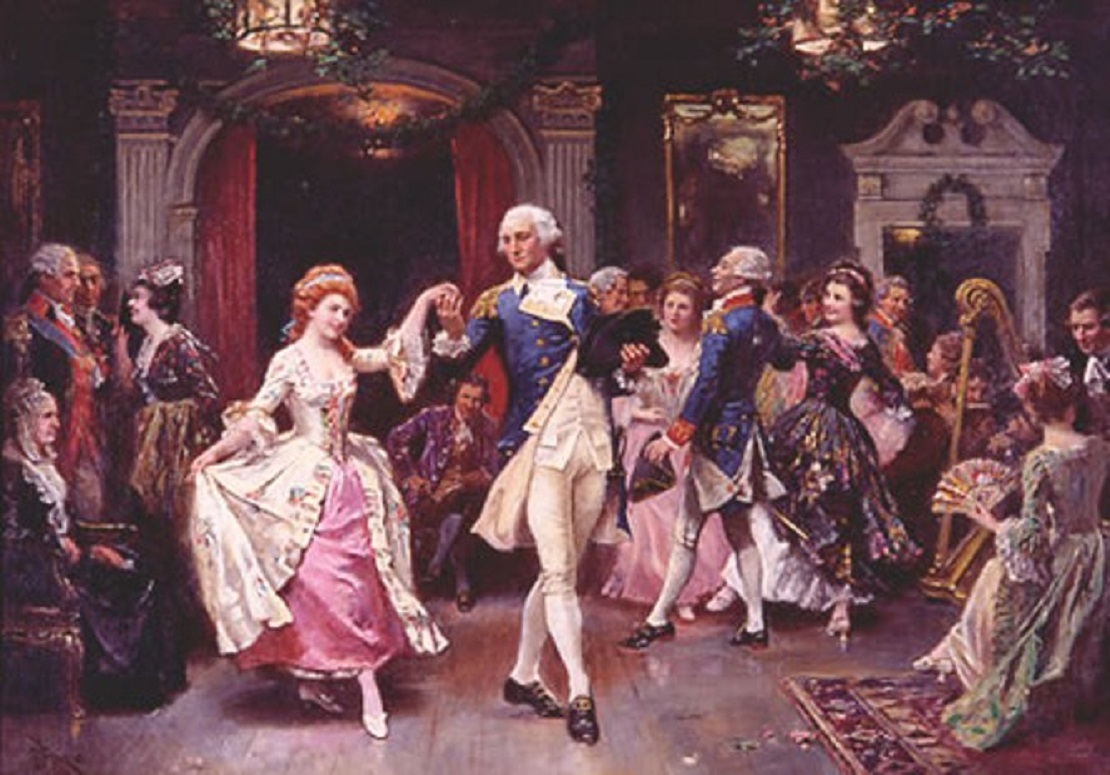 George
Washington cutting up the parquet during those cold American
Revolutionary War nights and even at a ball a month after his 1789
Inauguration, but the Father of Our Country always loved to end his
annual birthday party by dancing it up. At the annual “Birth Night” Ball
held in his honor, he was never once late to get that party started. Of
course, this was no swim, no bump, no hully-gully, no Charleston. This
was George Washington and what else could he have danced to preserve his
vaunted dignity but that stiff, formal.
George
Washington cutting up the parquet during those cold American
Revolutionary War nights and even at a ball a month after his 1789
Inauguration, but the Father of Our Country always loved to end his
annual birthday party by dancing it up. At the annual “Birth Night” Ball
held in his honor, he was never once late to get that party started. Of
course, this was no swim, no bump, no hully-gully, no Charleston. This
was George Washington and what else could he have danced to preserve his
vaunted dignity but that stiff, formal.In September 1746, George’s half-brother Lawrence and his friend and mentor Colonel William Fairfax, hatched a plan for the 14 year old that would have him joining a Royal Navy frigate anchored along the Virginia shore as a midshipmen.His mother was convinced that this was not a prudent career move and forbid it. Whether this decision came from reasoned analysis or a desire to retain her eldest son on the Fredericksburg farm, Mary Washington did the American cause a great service in withholding her approval.Washington's career as a professional surveyor began in 1749. He received a commission from the College of William and Mary to become surveyor for the newly formed Culpeper County, probably at the behest of William Fairfax who was then serving on the Governor's Council.Washington immediately traveled to Culpeper, the county seat, to be sworn in. Within two days, he completed his first survey measuring a tract of 400 acres for Richard Barnes. At seventeen years of age, he was well on his way to a lucrative career.By 1752, Washington had completed nearly 200 surveys totaling more than 60,00 acres. Among them was a survey of 269 acres for William Naylor on April 12, 1752. In accordance with a warrant he had received from the proprietor's office (Thomas Lord Fairfax), he surveyed "a certain tract of waste land" along the Cacapon River, approximately 20 miles west of present day Winchester, Virginia.At the age of 21, Washington was sent to lead a British colonial force against the French in Ohio.The war tested the relationships between America and the mother country. The decisions that arose from the conflict caused both the British and the Americans to question the nature of the colonial partnership. After the French and Indian War, it began to become apparent that America and Britain were developing culturally and socially along different lines, and the war exposed and exacerbated the fundamental differences between British and American goals. George Washington was a pivotal figure in the French and Indian War from the earliest days. For Washington the French and Indian War started in late 1753, when he was selected as the British emissary to the French frontier establishment. It ended with the fall of Fort Duquesne to the combined British and colonial forces. He was a young and ambitious man when he volunteered. His actions which reflected his lack of experience--and his ambitions helped determine the course of the war. The war was also an important event in Washington’s life and development. His later decisions and actions were influenced by his French and Indian War experience. Washington’s war experiences not only taught him valuable lessons about command and politics, they also caused him to re-examine his professional and personal goals. The war both provided Washington with valuable military experience and shaped his perceptions of the relationship between the colonials and the British. Washington emerged from the war as a less naïve person.Washington was an ambitious young man who wanted to pursue a military career. Before his death, Washington’s older, half-brother Lawrence Washington had a brevet officer’s commission in the regular British army during the British invasion of Cartagena and served as the military adjutant for Virginia. It was common in eighteenth-century Virginia for official positions to pass down within families, and it may have been with this in mind that Washington actively sought to succeed Lawrence as a military adjutant. The adjutants’ role was to instruct the militia officers and soldiers in the use and exercise of their arms, to increase discipline in the militia, and to teach the men of the lower classes how to be more civilized. The colonial government divided the colony into four military districts; Washington lobbied for the adjutancy of the Northern Neck, which included his home. However, Washington was appointed to the adjutancy of the Southern district, which stretched from the James River to the North Carolina border. While he was disappointed not to receive the district closer to home, it was an honor for the as not-yet-21-year-old Washington (who had no military experience) to be appointed to the adjutancy with its £100 per year salary and a Virginia Major’s commission.By the early 1750s the French and British were in conflict in the Ohio Valley. Since the beginning of European settlement in the seventeenth century, English settlement had slowly expanded westward from the eastern seaboard, while French settlement moved south from Canada. In the 1740s, British traders entered the Ohio Valley and began competing with already established French traders for Indian commerce. In 1744 the Iroquois signed the Treaty of Lancaster with the British, which ceded Iroquois claims in Maryland and Virginia. While the Iroquois assumed that this meant the Shenandoah Valley and land already within settled colonial boundaries, the British interpreted it as the entire area of English claim. Virginia’s charter specified that its western boundary was the Pacific Ocean. In 1745, the Virginia House of Burgesses began granting western land to Virginia-based land companies.The French saw this as a threat to their territorial claims, which were based on early exploration and settlement. In 1752 France sent the Marquis de Duquesne to be the governor-general of Canada and to command French forces in North America. Throughout the rest of 1752 and early 1753, the French built strategically located forts throughout the Ohio Valley to protect their claims.
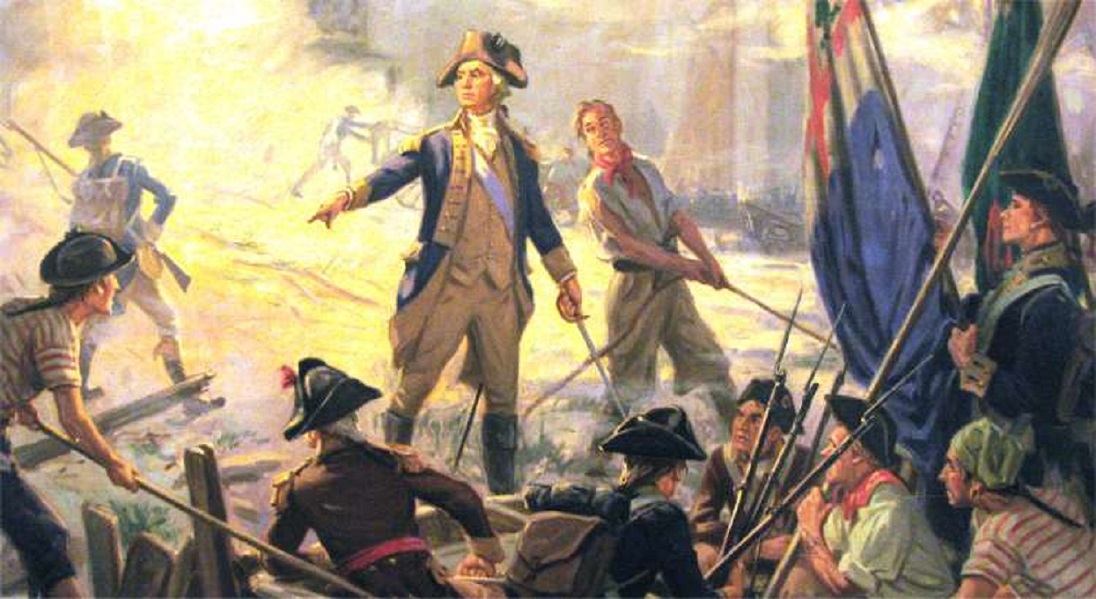 Battle of Long Island,following the successful siege of Boston, George Washington knew that
it was only a matter of time before the British returned with more men,
and he was certain that General Howe's objective would be the city of
New York.While Washington strengthened his positions in lower Manhattan, he
also fortified Brooklyn Heights, across the East River on Long Island.
It was there, on August 27, 1776, that Howe landed his troops and
succeeded in flanking the American position through the unguarded
Jamaica Pass. While soundly defeated, Washington was able to execute a
nighttime evacuation of Long Island that saved close to 9,000 troops.
Battle of Long Island,following the successful siege of Boston, George Washington knew that
it was only a matter of time before the British returned with more men,
and he was certain that General Howe's objective would be the city of
New York.While Washington strengthened his positions in lower Manhattan, he
also fortified Brooklyn Heights, across the East River on Long Island.
It was there, on August 27, 1776, that Howe landed his troops and
succeeded in flanking the American position through the unguarded
Jamaica Pass. While soundly defeated, Washington was able to execute a
nighttime evacuation of Long Island that saved close to 9,000 troops.
 The
Death of General Mercer at the Battle of Princeton, January 3, 1777 is
the title of an oil painting by the American artist John Trumbull
depicting the death of the American General Hugh Mercer at the Battle of
Princeton on January 3, 1777 during the American Revolutionary War. The
painting was Trumbull’s first depiction of an American victory. It is
one of a series of historical paintings on the war, which also includes
the Declaration of Independence and The Capture of the Hessians at
Trenton, December 26, 1776.
The
Death of General Mercer at the Battle of Princeton, January 3, 1777 is
the title of an oil painting by the American artist John Trumbull
depicting the death of the American General Hugh Mercer at the Battle of
Princeton on January 3, 1777 during the American Revolutionary War. The
painting was Trumbull’s first depiction of an American victory. It is
one of a series of historical paintings on the war, which also includes
the Declaration of Independence and The Capture of the Hessians at
Trenton, December 26, 1776.
In June 1775, Congress ordered General George Washington to take command of the Continental Army besieging the British in Boston. Despite having little practical experience in managing large, conventional armies, Washington proved to be a capable and resilient leader of the American military forces during the war. While he lost more battles than he won, George Washington employed a winning strategy that included signal victories at the Battle of Trenton in 1776 and Yorktown in 1781. Washington’s greatest wartime legacy was his decision to surrender his commission to Congress, affirming the principle of civilian control of the military in the new United States.During the Revolutionary War, Washington was the highest ranking officer as a three-star lieutenant general. Since that time, any four or five-star general has outranked him. Until the 1970’s, that is. January 19, 1976, approaching the 200th anniversary of our nation, Congress approved to promote Washington to General of the Armies. The rank is the highest one can achieve in the U.S. Army and has only been achieved twice, the other being John J. Pershing during World War I. Washington was officially promoted as General of the Armies of the United States on March 13, 1978, with the effective date being July 4, 1776. Congress also cleared up any confusion by declaring Washington would outrank any past, present, or future general. Sorry, General Pershing.In the first years of the Revolutionary War, George Washington and his Continental Army faced a threat that proved deadlier than the British: a smallpox epidemic, lasting from 1775-1782. Infrequent outbreaks and wariness of inoculation made his troops very susceptible to the disease. After heavy losses in Boston and Quebec, Washington implemented the first mass immunization policy in American history. Smallpox, caused by the Variola major virus, spreads only from person to person. It can take up to fourteen days before a person exposed to the virus will show symptoms: fever, headaches, body pains, and eventually the telltale rash. Witnesses and survivors of smallpox describe immense suffering. Death often comes within about two weeks. Survivors can take up to a month to recover fully; they are left with scars, but also lifetime immunity. European colonization introduced smallpox to the Americas in the sixteenth century. Over the course of a little more than three centuries, outbreaks of the disease appeared sporadically in colonial America. In Europe, smallpox became an endemic disease by the eighteenth century; exposure often happened in childhood, which meant that virtually the entire adult population was immune. The American colonists, however, might have gone for years without any exposure to smallpox. It is difficult to track smallpox deaths during the Revolutionary War, but estimates indicate that Washington’s army lost more troops to disease in general than in combat. One study suggests that for every soldier who fell to the British, ten died from some sort of disease. Washington himself was no stranger to smallpox; while traveling in Barbados in 1751, he contracted the disease while staying with Gedney Clarke. However, Washington did not keep a record of his illness. His case was mild, leaving him with scarring on his nose.Colonies dealt with smallpox in two different ways: quarantine and inoculation. Each colony had its own quarantine laws, which took different forms and were often enforced at the local level. Some colonials, particularly the wealthy, chose to be inoculated. Inoculation involved deliberate exposure to smallpox, usually through an incision made on the arm. This still resulted in a case of smallpox, but frequently one with milder symptoms and a greater chance of survival, with immunity as the end goal. Many were opposed to inoculation because the practice could still lead to an outbreak if an inoculated person was not properly quarantined while ill. Inoculation was heavily regulated, and banned outright in some places. Combined with the procedure’s expense, this made it a rare practice in America.Immunity to smallpox became an important factor during the Revolutionary War in two ways. First, the British and Continental forces were disproportionately affected by the epidemic. The British troops arriving from Europe were more likely to be immune to the disease, either through inoculation or natural exposure. This was not true of Washington’s forces. As soldiers concentrated themselves in camp, the chances of a smallpox outbreak increased. Second, the British took quickly to inoculating fresh troops because the chances of triggering an outbreak were slim. Washington, on the other hand, struggled with the question of inoculation. Doing so would not only risk an outbreak; it would also leave a portion of the army unfit for battle while they recovered. It was for these reasons that Washington decided against inoculation during his army’s first encounter with smallpox: the Siege of Boston in 1775. Civilians and soldiers who showed symptoms were kept from the rest of the army. When safe passage out of Boston was secured for some, the presence of smallpox was taken into account. There is some indication that the British, going against the agreement, used the disease as a biological weapon by forcing potentially infected Bostonians to leave the city. When the British gave up the city in the spring of 1776, the outbreak became even harder to control. Refugees spread smallpox throughout Massachusetts, and Boston’s outbreak continued until the end of summer. During the same period, the Continental forces besieging Quebec also suffered great losses due to smallpox. The soldiers were already in poor health, making them more susceptible. A quarantine was put in place, but it was not enforced strongly enough. When they were forced to retreat, smallpox went with them. These losses signaled to Washington and other revolutionary leaders that the army’s smallpox policy was not effective.After weeks of indecision, Washington issued the order to have all troops inoculated on February 5, 1777, in a letter to President John Hancock. The next day, a second letter was sent to Dr. William Shippen, Jr. that ordered all recruits arriving in Philadelphia to be inoculated:“Finding the Small pox to be spreading much and fearing that no precaution can prevent it from running through the whole of our Army, I have determined that the troops shall be inoculated. This Expedient may be attended with some inconveniences and some disadvantages, but yet I trust in its consequences will have the most happy effects. Necessity not only authorizes but seems to require the measure, for should the disorder infect the Army in the natural way and rage with its usual virulence we should have more to dread from it than from the Sword of the Enemy.” The practice was soon implemented across the colonies. Army physicians also inoculated veteran soldiers who had yet to be exposed. Washington needed the process to be done in secret. He feared that the British would learn of the army’s temporary weakness and use it to their advantage. In March 1778, the inoculation orders were altered slightly. At Valley Forge, Washington encountered thousands of troops that had managed to avoid smallpox, either through inoculation or natural exposure. In need of immediate reinforcements, Washington realized that the army might not survive the delay of inoculation. Instead, he ordered that inoculations continue at the camp in Valley Forge. If quarantine procedures failed, there was a risk of an outbreak. However, the soldiers awaiting inoculation could be called to the front lines if necessary.
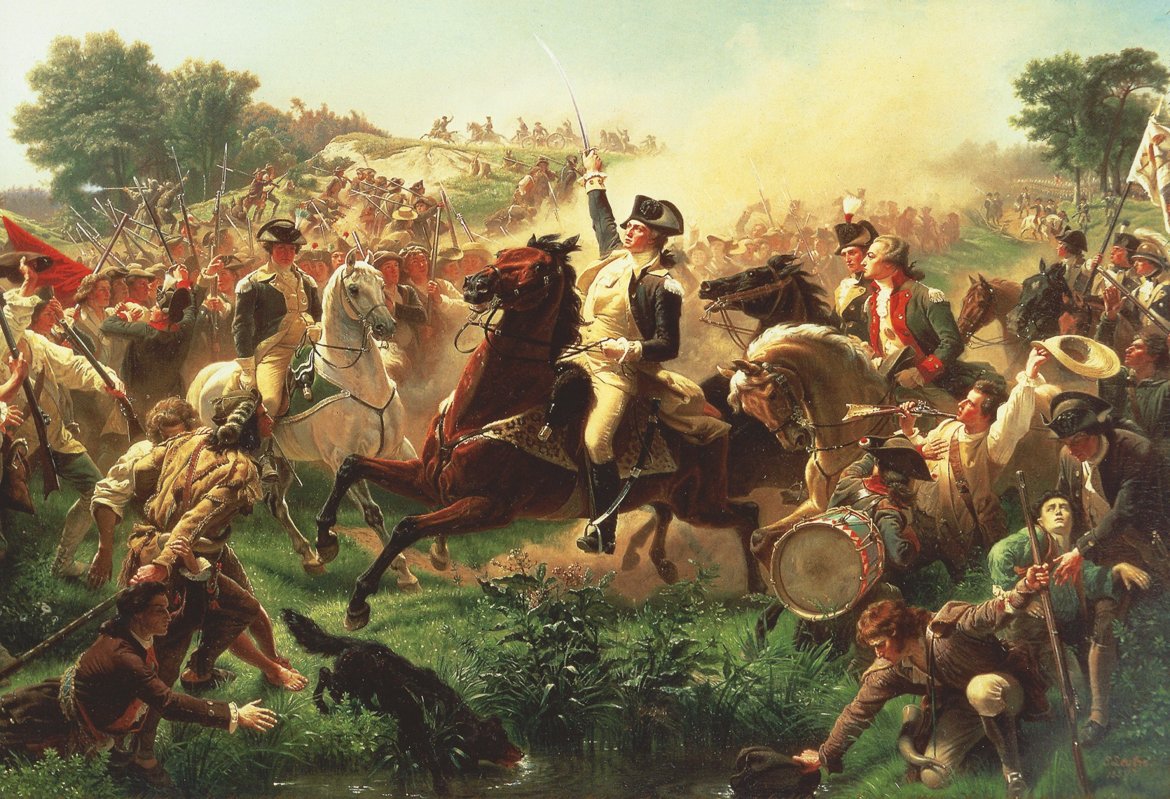 Battle of Monmouth,following his selection as a replacement for General Howe, General
Sir Henry Clinton ordered British troops to withdraw from Philadelphia
in order to safeguard New York City from a possible attack by American
and French forces. George Washington decided that the British retreat
from Philadelphia provided his troops with the perfect opportunity to
attack. General Charles Lee would lead an advanced guard of 5,000 troops
meant to harass and occupy the British rear guard until Washington could
arrive with another 6,000 men. On June 28, 1778, Lee engaged the rear
of the British army, but found himself being pushed back by British
reinforcements. Much to Washington's dismay, Lee began to withdraw his
troops from the battlefield.
Battle of Monmouth,following his selection as a replacement for General Howe, General
Sir Henry Clinton ordered British troops to withdraw from Philadelphia
in order to safeguard New York City from a possible attack by American
and French forces. George Washington decided that the British retreat
from Philadelphia provided his troops with the perfect opportunity to
attack. General Charles Lee would lead an advanced guard of 5,000 troops
meant to harass and occupy the British rear guard until Washington could
arrive with another 6,000 men. On June 28, 1778, Lee engaged the rear
of the British army, but found himself being pushed back by British
reinforcements. Much to Washington's dismay, Lee began to withdraw his
troops from the battlefield.
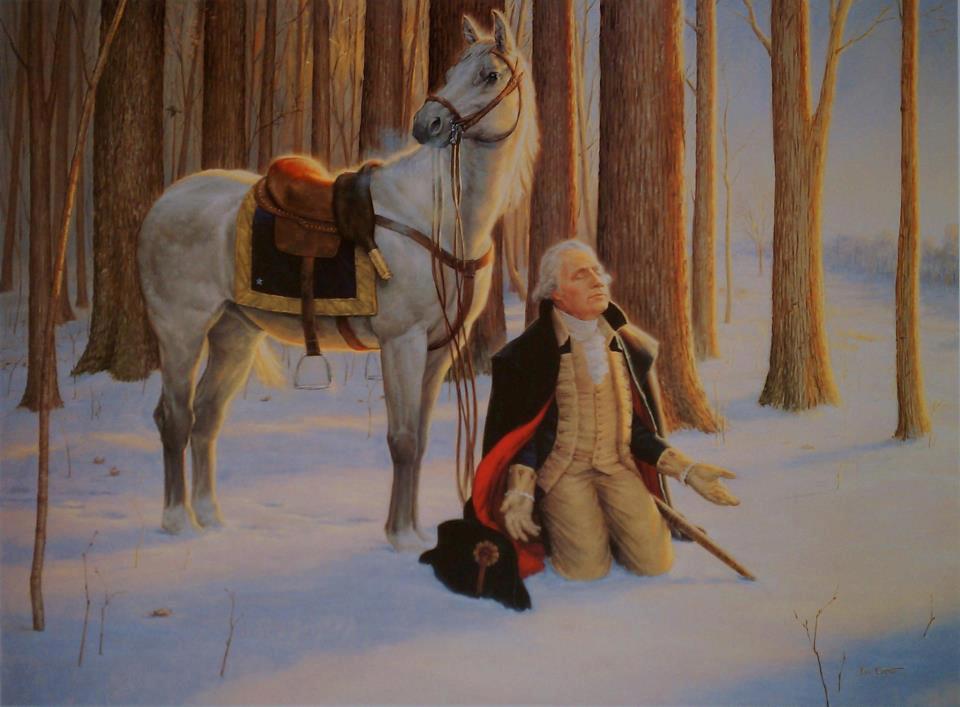 The
Prayer at Valley Forge, a depiction of George Washington praying at
Valley Forge.George Washington on his knees alone, with his sword on one
side and his cocked hat on the other. He was at Prayer to the God of
the Armies, beseeching to interpose with his Divine aid, as it was ye
Crisis, & the cause of the country, of humanity & of the world.
The
Prayer at Valley Forge, a depiction of George Washington praying at
Valley Forge.George Washington on his knees alone, with his sword on one
side and his cocked hat on the other. He was at Prayer to the God of
the Armies, beseeching to interpose with his Divine aid, as it was ye
Crisis, & the cause of the country, of humanity & of the world.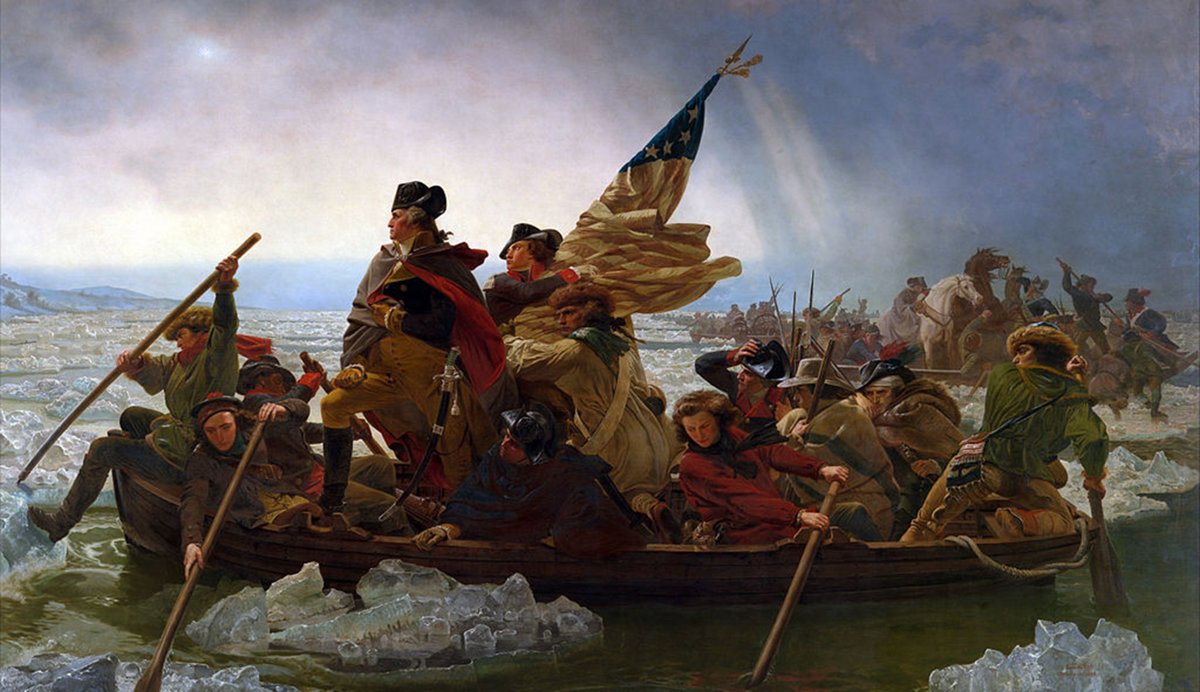 This
pewter plate pictures Washington crossing the Delaware on December 25,
1776 ready to attack Trenton. It was made in Canton, Ohio in 1976 to
commemorate our country's 200th birthday. There are many maker markings
on the back along with an appropriate hanger. Great vintage condition.
We have a set of 6 plates total and are willing to give a discount on
price and shipping if you are interested in more than one.
This
pewter plate pictures Washington crossing the Delaware on December 25,
1776 ready to attack Trenton. It was made in Canton, Ohio in 1976 to
commemorate our country's 200th birthday. There are many maker markings
on the back along with an appropriate hanger. Great vintage condition.
We have a set of 6 plates total and are willing to give a discount on
price and shipping if you are interested in more than one.
On April 30, 1789, George Washington was inaugurated as the first president. The path to the presidency, and the task of leading a new nation, was uncharted territory for which there was no precedent.George Washington, as the first president, was well aware of the great responsibility of defining the American presidency.The first presidential election, George Washington was unanimously elected president of the United States. With 69 electoral votes, Washington won the support of each participating elector. No other president since has come into office with a universal mandate to lead.Between December 15, 1788 and January 10, 1789, the presidential electors were chosen in each of the states. On February 4, 1789, the Electoral College convened. Ten states cast electoral votes: Connecticut, Delaware, Georgia, Maryland, Massachusetts, New Hampshire, New Jersey, Pennsylvania, South Carolina, and Virginia. New York, however, failed to field a slate of electors. North Carolina and Rhode Island were unable to participate because they had not yet ratified the Constitution. After a quorum was finally established, the Congress counted and certified the electoral vote count on April 6.Washington was both an obvious first choice for president and possibly the only truly viable choice. He was both a national hero and the favorite son of Virginia, the largest state at the time. Washington ascended to the presidency with practical experience, having served as the commander-in-chief of the Continental Army during the American Revolution and president of the 1787 Constitutional Convention in Philadelphia.According to Article II of the Constitution, each elector in the Electoral College possessed two votes. The candidate whoA recreation of Washington's inauguration, from Mount Vernon's Ford Orientation Center received a majority of the votes was elected president. The candidate with the second most votes in the Electoral College, whether a majority or a plurality, was elected vice president. Behind Washington, John Adams, who most recently had served as the first U.S. ambassador to Great Britain, finished with 34 electoral votes and became the first vice president of the United States. Five candidates split the remaining seven votes. Upon hearing the news of his decisive election, Washington set out from Mount Vernon to take his place in presidential history. Though filled with great anxiety, Washington reported for duty "in obedience to the public summons" and explained that "the voice of my Country called me."On April 30, 1789, at Federal Hall in New York City, the first capital of the United States, Washington took the presidential oath of office. With a hand on the Bible, a "sacred volume" borrowed from a local Masonic lodge and subsequently known as the "George Washington Inaugural Bible," he said, "I, George Washington, do solemnly swear that I will faithfully execute the Office of President of the United States, and will to the best of my Ability, preserve, protect and defend the Constitution of the United States." At that moment, the Chancellor of the State of New York, Robert Livingston, the person who administered the oath to the first chief executive, exclaimed, "Long live George Washington, President of the United States!"Washington believed that the precedents he set must make the presidency powerful enough to function effectively in the national government, but at the same time these practices could not show any tendency toward monarchy or dictatorship.In addition to defining the actual powers of the office, Washington also needed to show the new nation how the leader of a democracy should behave socially.Washington married a wealthy widow, Martha Dandridge Custis, in January 1759. The couple had no children of their own, but raised Martha’s together. Inheriting Mt. Vernon, a family plantation on the Potomac River, in 1761, Washington spent the next 15 years as a planter, also serving in the House of Burgesses (the colonial legislature in Virginia). He took the patriot side in the disputes with Great Britain in the 1760s and 1770s, and was elected to the first Continental Congress in 1774. With the coming of open war with Britain in 1775, the congress decided to make Washington commander in chief of the new Continental Army. Washington had as much military experience as anyone in the colonies, and his selection helped gain the allegiance of Virginia, by far the most populous of the 13 colonies.After accepting the British surrender at Yorktown in October 1781, Washington retired to Mt. Vernon to revive his plantation and financial position. He was elected to the Constitutional Convention (1787) and reluctantly served as its presiding officer. Washington’s support of the Constitution was critical in its acceptance by the states. He was a virtually unanimous choice for the nation’s first president. Washington served two terms (1789-1797) and could easily have gained a third had he wished to. Instead, he established the precedent of a two-term maximum, which remained unchallenged until 1940. Washington died in 1799, as much from incompetent medical treatment as the underlying disease. A slaveholder throughout his life, Washington freed his bondspeople at his death.
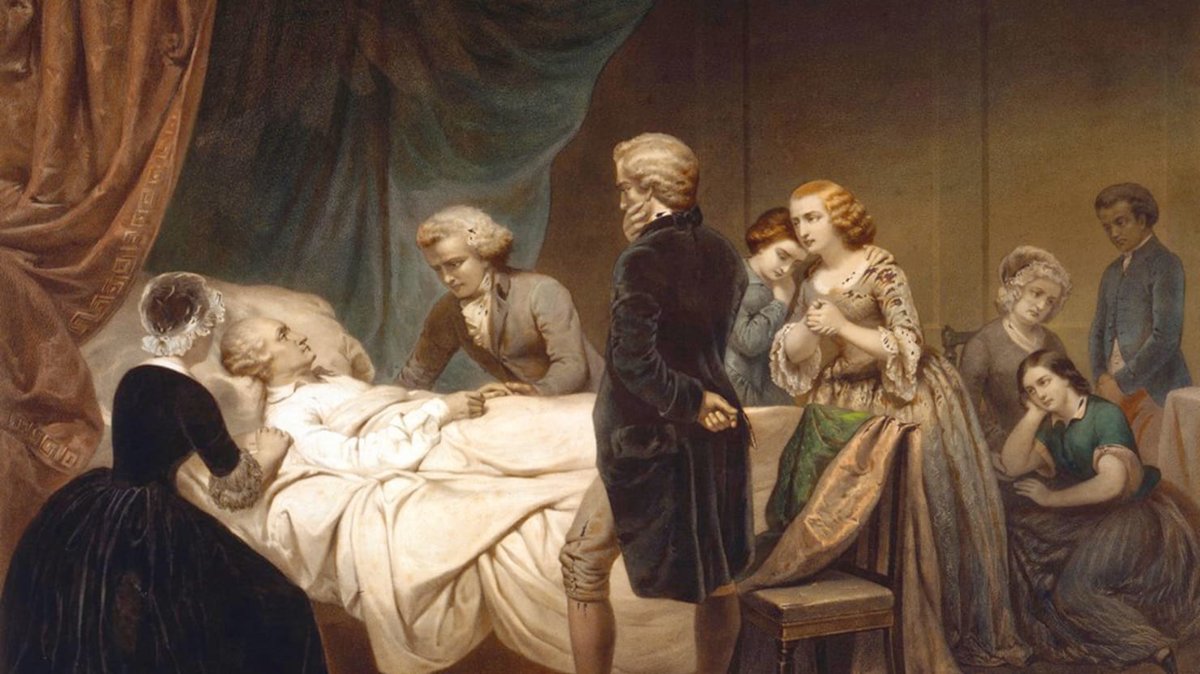 The
death of George Washington, George Washington's final moments. - Life
of George Washington: The Christian, lithograph by Claude Regnier, after
Junius Brutus Stearns,1853. Gift of Mr. and Mrs. Robert B. Gibby.
December 12, 1799, George Washington was out on horseback supervising
farming activities from late morning until three in the afternoon. The
weather shifted from light snow to hail and then to rain. Upon
Washington's return it was suggested that he change out of his wet
riding clothes before dinner. Known for his punctuality, Washington
chose to remain in his damp attire.
The
death of George Washington, George Washington's final moments. - Life
of George Washington: The Christian, lithograph by Claude Regnier, after
Junius Brutus Stearns,1853. Gift of Mr. and Mrs. Robert B. Gibby.
December 12, 1799, George Washington was out on horseback supervising
farming activities from late morning until three in the afternoon. The
weather shifted from light snow to hail and then to rain. Upon
Washington's return it was suggested that he change out of his wet
riding clothes before dinner. Known for his punctuality, Washington
chose to remain in his damp attire.

